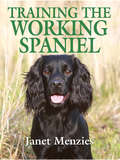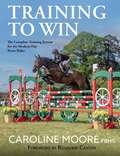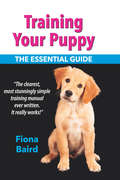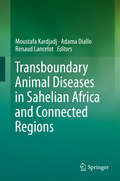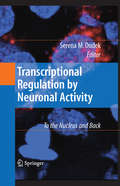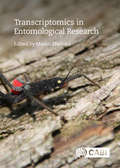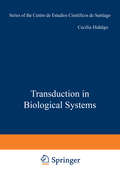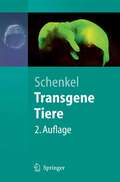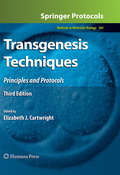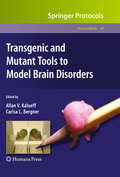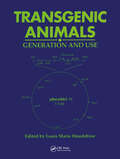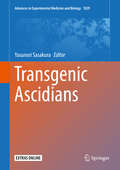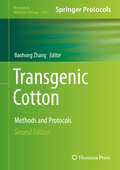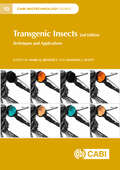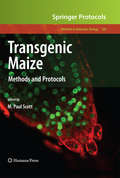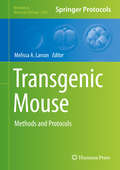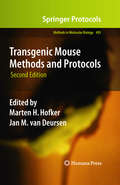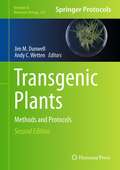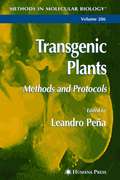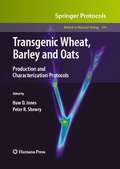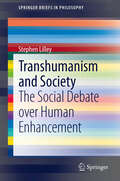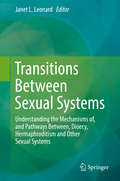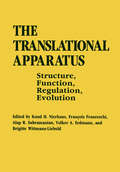- Table View
- List View
Training the Working Spaniel
by Janet MenziesTraining the Working Spaniel makes it simple for anyone to train their gundog, no matter what facilities are available. The book contains chapters on training the urban gundog; how to keep a working dog in a family home; and introducing first-timers to working their spaniel in a variety of shooting situations. The author takes the reader, whether novice or experienced, all the way from teaching the pup to hup to competing in field trials at the highest levels. The book covers everything from the first lessons in sitting and staying, to working on live game. It then covers advanced work in the field, rough shooting, picking-up, and training as a peg dog. The final part of the book introduces the reader to elite spaniel work in field trials as well as giving guidance on breeding your own dogs. With unique access to the most successful spaniel trainers, the author brings exclusive tips from the top that can be used by any beginner.
Training Your Puppy: The Essential Guide
by Fiona BairdFollow these simple instructions and your puppy should develop into a delightful, obedient and devoted member of your family. He will bring you great companionship and happiness for many years to come. There are many puppy-training books available today, but none so clear and coherent as this one. There is a strong logic to Fiona Baird’s method which gives confidence to both owner and puppy. She makes training fun, simple and very straightforward. Fiona Baird has trained countless puppies professionally, and has many devoted clients. She truly is the Mary Poppins of puppy training.
Trains Trains Trains!: Find Your Favourite (50 to Follow and Count)
by Donna DavidBig trains, small trains, short trains, long trains . . . which do you like best? Follow fifty colourful trains as they whizz along tracks and through tunnels – up, down, around and back again! Can you find your favourite?Full of spotting and counting fun, with five trains to find on each page and an exciting fold-out race at the end, this rhyming preschool picture book from Donna David and Nina Pirhonen has been specially developed to encourage pre-reading skills and expand language and vocabulary.With a super-shiny foil cover and fun read-aloud text, Trains Trains Trains! is just the ticket for any transport-obsessed toddler!
Transboundary Animal Diseases in Sahelian Africa and Connected Regions
by Moustafa Kardjadj Adama Diallo Renaud LancelotThis book primarily focuses on the African Sahel region, shedding new light on the epidemiology, socio-economics, clinical manifestations and control approaches of transboundary animal diseases (TADs) in this specific region. In addition to the description of TADs in Sahelian Africa and connected regions, several issues regarding the burden of TADs, the role of national/regional/international veterinary organizations in the surveillance process, animal mobility, one health and TADs in the dromedary are discussed. The book contains 22 chapters and is structured in three parts, i- general features and commonalities, ii- viral diseases, iii- bacterial diseases. Each chapter was written by a group of experts specialized in the topic. This work will be of general interest to researchers, veterinarians, veterinary public health officers, and students engaged in the surveillance and control of animal infectious diseases, included those of zoonotic nature and that are prevalent in the Sahel.
Transcriptional Regulation by Neuronal Activity: To the Nucleus and Back
by Serena DudekRegulation of gene transcription by neuronal activity is evident in a large number of neuronal processes ranging from neural development and refinement of neuronal connections to learning and response to injury. In the field of activity-dependent gene expression, rapid progress is being made that can impact these, and many other areas of neuroscience. This book offers an up-to-date picture of the field.
Transcriptomics in Entomological Research
by May R Berenbaum Bernarda Calla Joanna C. Chiu Jürgen Ehlting Melanie Gee Aman Gill Martin Hasselmann Matthew Huff Brian R Johnson Juan Luis Jurat-Fuentes William E Klingeman Kyle M. Lewald Shanlin Liu Antonino Malacrinò Guanliang Meng Yoonseong Park Amber Rose Paulson Steven J Perlman Ratnasri Pothula Sampurna Sattar Margaret E Staton James P Tauber Gary A Thompson Patrick Von Aderkas Will Kipling Chengran ZhouBridging the gap between genome and phenotype, the transcriptome is a molecular-level snapshot of the act of living. Transcriptomics shows which genes are expressed into proteins in a specific tissue of a specific organism at a specific time and condition. This book gives an account of the extraordinary diversity of ways transcriptomics has been and can be utilised in basic and applied entomological research. It encompasses a vast range of disciplines within entomology, applying transcriptomics to the study of over one million described species of insects. It covers a vast range of disciplines from phylogenomics to pest management, from ecology to physiology, and from behavior to evolutionary biology. The book covers the breadth and depth of transcriptomics use in research to showcase the utility of this technology in all disciplines. Research examples in the book are relevant to fish, birds, plants, and fungi, as well as insects and other arthropods, helping scientists in any field, using any system, to understand what transcriptomics can do for them. The book: Introduces transcriptomics theory and practice for researchers of all levels wishing to gain an insight into how to apply these techniques to their own fields. Showcases the myriad ways transcriptomics can be used to answer biological questions. Is written by a team of international experts describing their own experiences, giving guidance for applying it to the reader's own work. Reviews how transcriptomics research has helped entomologists push their fields further and make new discoveries.
Transduction in Biological Systems (Series of the Centro De Estudios Científicos)
by Cecilia Hidalgo Juan Bacigalupo Enrique Jaimovich Julio VergaraThe present volume originated from the workshop "Transduction in Biological Sys tems," held at the Marine Biological Station of the Universidad de Valparaiso, Mon temar, Chile, May 23-30, 1988, and contains contributions from most of the partici pants in the workshop. The title of both the workshop and the book reflects accurately the central theme discussed during several days of intense debate and profound intellectual exchange in the peaceful environment offered by the central coast of Chile. It was apparent that the workshop was a great success-a sentiment expressed by many seasoned attendees, some of whom dared opinions as strong as "It was the best ever." There is no single reason to explain why this workshop was so successful. Certainly instrumental was the incredible effort displayed by the Chilean Organizing Committee in selecting adequate facilities and in organizing social events that supplemented the scien tific sessions and provided an authentic fraternal environment for the participants. Equally important were the foreign participants, who enthusiastically gave of their time to take part in the event, and the students, who came from Chile as well as from several other Latin American countries, and who applied the necessary pressure in their repeated demands for scientific clarity, accuracy, and sincerity.
Transgene Tiere (Springer-Lehrbuch)
by Johannes SchenkelDer Autor beschreibt anschaulich die Techniken, mit denen Gene mutiert, in Tiere eingebracht und diese Tiere gezüchtet werden können. Screening-Methoden zum Nachweis des Transgens werden ebenso ausführlich erklärt wie Zucht, Haltung und Sicherung transgener Tiere. Weitere Themen sind die Transgenese in anderen Spezies, ethische Aspekte, Sicherheitsfragen, rechtliche Voraussetzungen sowie der Tierschutz. Für die völlig überarbeitete 2. Auflage wurden u. a. die Abschnitte zu transgener Technologie sowie zu Zucht und Haltung aktualisiert bzw. ergänzt.
Transgenesis Techniques: Principles and Protocols (Methods in Molecular Biology #561)
by Elizabeth J. CartwrightOne of the major challenges currently facing the scientific community is to understand the function of the multitude of protein-coding genes that were revealed when the human genome was fully sequenced. In Transgenesis Techniques: Principles and Protocols, Third Edition, experts in the field fully update and expand upon the previous edition in order to detail the transgenic techniques currently used to modify the genome. The volume explores classic procedures to genetically modify mice and other model organisms, as well as cutting-edge practices involving microinjection, site-specific recombination systems, cryopreservation, and many other topics. Written in the highly successful Methods in Molecular Biology™ series format, the chapters include brief introductions to their subjects, lists of the necessary materials and reagents, step-by-step, readily reproducible laboratory protocols, and notes sections, highlighting tips on troubleshooting and avoiding known pitfalls. Comprehensive and state-of-the-art, Transgenesis Techniques: Principles and Protocols, Third Edition is a comprehensive practical guide to the generation of transgenic animals and an invaluable source of information in any lab currently involved in transgenic techniques.
Transgenic and Mutant Tools to Model Brain Disorders (Neuromethods #44)
by Allan V. Kalueff and Carisa L. BergnerAs the presence of genetically modified animal models in research laboratories has multiplied, the role of genetic factors in the pathogenesis of brain disorders has become particularly important. The refinement of molecular genetic methods has continued to broaden our understanding of the genetic factors associated with a variety of disorders. In "Transgenic and Mutant Tools to Model Brain Disorders", leading scientists specializing in this field contribute a timely collection of recent advances featuring a vast array of topics in order to contribute to the diverse approaches taken toward the evaluation of genetically modified models in biomedical research. Opening with several chapters covering general aspects of genetically modified animal models, the book then continues with detailed chapters on models of specific human brain disorders, including OCD, Rett Syndrome, anxiety disorders, depression, and schizophrenia. As a volume in the successful Neuromethods™ series, the chapters provide authoritative reviews covering the most commonly used approaches in the field. Cutting-edge and concise, "Transgenic and Mutant Tools to Model Brain Disorders" offers a comprehensive and descriptive overview on a variety of topics in neuroscience and biological psychiatry.
Transgenic Animals
by Louis-Marie HoudebineDuring the past 20 years, transgenesis has become a popular technique and a crucial tool for molecular geneticists and biologists. Transgene expression is now better-controlled and even specifically inducible by exogenous factors. While these techniques have quite significantly transformed the experimental approaches taken by biologists, the applications are more limited than expected and concerns have arisen regarding biosafety as well as physiological, social, and philosophical issues. Transgenic Animals: Generation and Use contains articles on the techniques used to generate transgenic animals and a section on the preparation of vectors for the optimally controlled expression of transgenes. It also examines the use of transgenic animals in the study of gene function and human diseases, the preparation of recombinant proteins and organs for pharmaceutical and medical use, and the improvement of genetic characteristics of farm animals. Finally, it discusses more recent problems generated by transgenic animals including conservation of transgenic lines, specific database patenting, biosafety, and bioethics.Drawn from both academia and industry, the contributors to this monograph present in one concise volume all the relevant information on the different aspects of transgenesis. This book can be used as both a reference book and a textbook for specialized university courses and will be of interest to everyone involved in basic research in animal biology, molecular genetics, animal biotechnology, pharmaceutical science, and medicine.
Transgenic Animals: Generation And Use
by Louis-Marie HoudebineDuring the past 20 years, transgenesis has become a popular technique and a crucial tool for molecular geneticists and biologists. Transgene expression is now better-controlled and even specifically inducible by exogenous factors. While these techniques have quite significantly transformed the experimental approaches taken by biologists, the applications are more limited than expected and concerns have arisen regarding biosafety as well as physiological, social, and philosophical issues. Transgenic Animals: Generation and Use contains articles on the techniques used to generate transgenic animals and a section on the preparation of vectors for the optimally controlled expression of transgenes. It also examines the use of transgenic animals in the study of gene function and human diseases, the preparation of recombinant proteins and organs for pharmaceutical and medical use, and the improvement of genetic characteristics of farm animals. Finally, it discusses more recent problems generated by transgenic animals including conservation of transgenic lines, specific database patenting, biosafety, and bioethics.Drawn from both academia and industry, the contributors to this monograph present in one concise volume all the relevant information on the different aspects of transgenesis. This book can be used as both a reference book and a textbook for specialized university courses and will be of interest to everyone involved in basic research in animal biology, molecular genetics, animal biotechnology, pharmaceutical science, and medicine.
Transgenic Ascidians (Advances in Experimental Medicine and Biology #1029)
by Yasunori SasakuraThis book comprehensively describes the transgenesis techniques and applied experimental methods in ascidians including enthusiastically developed original devices in addition to concrete examples of developmental biology studies. Ascidians have been one of the most important model animals in developmental biology for studying molecular and cellular processes underlying formation of the chordate body plan. Transgenic techniques such as microinjection, electropolation, cis-element analysis and application, and TALENs and CRISPR/Cas9 have been developed in ascidians for more than 20 years, and now many applied methods, some of which are unique in ascidians, have been accumulated. Those extensive technological innovations, such as cell isolation, cell labeling, germ-line transformation, marker transgenic lines, and the experimental systems for studying notochord formation and nervous system, are exceptional particularly in marine invertebrates. This book is useful for ascidian researchers to quickly access the techniques in which they are interested as well as to compare each technology to become familiar with specialized tips, and for biologists of other organisms to learn the unique techniques and ingenious attempts specific to ascidians. Providing detailed and easily understandable descriptions of techniques, the book will inspire ascidian specialists to improve their techniques, encourage anyone wanting to begin studying ascidians, and enable readers to immediately apply the techniques to the organisms they research.
Transgenic Cotton: Methods and Protocols (Methods in Molecular Biology #1902)
by Baohong ZhangThis second edition provides a comprehensive collection of the cutting-edge methods for creating and monitoring transgenic cotton and its application on agricultural and basic research. Chapters detail current status and perspectives of transgenic cotton, principle and methods for making transgenic cotton, creating gene knockout lines, foreign gene copy and expression in transgenic plants, improvements to cotton using transgenic technology, and monitoring the potential impact of transgenic cotton on environment. Written in the highly successful Methods in Molecular Biology series format, chapters include introductions to their respective topics, lists of the necessary materials and reagents, step-by-step, readily reproducible laboratory protocols, and tips on troubleshooting and avoiding known pitfallsAuthoritative and cutting-edge, Transgenic Cotton: Methods and Protocols 2nd aims to be a resource for scientists as well as graduate students who work on transgenic plants, plant genetics, molecular biology, and agricultural sciences.
Transgenic Insects: Techniques and Applications (CABI Biotechnology Series #3)
by Hassan M. Ahmed Omar S. Akbar Serap Aksoy Yehonatan Alcalay Luke Alphey Yael Arien Rotem Daniel Avraham Camilla Beech Nicholas J. Bongio Vanessa Bottino-Rojas L. Roman Carrasco Lucy Carter Jackson Champer Isabelle Coche Carolina Concha Rocco D’Amato Brinda Dass Jason A. Delborne Ellen M. Dotson Ravi V. Durvasula Matthew P. Edgington Claudia Emerson Guido Favia Adam P. Forshaw Alexander W.E. Franz Marisa L. Guido Monika Gulia-Nuss Daniella An Haber Andrew Hammond Alfred M. Handler Keith R. Hayes Ivy Hurwitz Anthony A. James Thomas P. Kelly Nicole Klein Ana Kormos Lee Benjamin Lamdan David J. Lampe Rosemary S. Lees Maria Vittoria Mancini Aditi Mankad John Mumford Tony Nolan Andrew Nuss David A. O’Brochta Riccardo Papa Philippos Aris Papathanos Michael Pham Ricardo Pereira Megan Quinlan Robyn Raban Jason L. Rasgon Aaron Roberts Yasha Rohwer Nathan Rose Marc F. Schetelig Kristof De Schutter Hideki Sezutsu Arvind Sharma Gregory S. Simmons Guy Smagghe Toshiki Tamura Delphine Thizy Lea Pare Toe Brian L. Weiss Ernst A. Wimmer Liu YangTechnology for modifying the genotypes and phenotypes of insects and other arthropods has steadily progressed with the development of more precise and powerful methods, most prominently transgenic modification. For many insect pests, there is now almost unlimited ability to modify phenotypes to benefit human health and agriculture. Precise DNA modifications and gene drive have the power to make wild-type populations less harmful in ways that could never have been performed with previous transgenic approaches. This transition from primarily laboratory science to greater application for field use has also necessitated greater development of modeling, ethical considerations and regulatory oversight. The 2nd Edition of Transgenic Insects contains chapters contributed by experts in the field that cover technologies and applications that are now possible. This edition includes increased attention to associated challenges of risk assessment, regulation, and public engagement. Featuring: Up-to-date analysis of molecular techniques, such as gene editing. Consideration of public attitudes and regulatory aspects associated with transgenic insects. Many examples of the wide range of applications of transgenic insects. This book will be very valuable to students and researchers in entomology, molecular biology, genetics, public health and agriculture, and will also appeal to practitioners who are implementing the technology, and to regulators, stakeholders and ethicists.
Transgenic Maize: Methods and Protocols (Methods in Molecular Biology #526)
by M. Paul ScottAs increasing global population and continuing economic development ensure the need for further production and cultivation of maize, the necessity of the application of transgenic technology to this model species and crop plant grows steadily. In Transgenic Maize: Methods and Protocols, experts in the various disciplines of the field contribute readily reproducible protocols covering such topics as transformation methods, transgenic maize in research, the analysis of transgenic plants, and breeding with transgenes. Written in the highly successful Methods in Molecular Biology™ series format, the chapters present brief introductions to their respective topics, lists of the necessary materials and reagents, step-by-step laboratory protocols, and notes on troubleshooting and avoiding known pitfalls. Cutting-edge and easy to use, Transgenic Maize: Methods and Protocols will greatly aid researchers wishing to use these procedures in their own laboratories, and will provide readers with a better understanding of the experiments being performed by cooperators or fee-for-service labs.
Transgenic Mouse: Methods and Protocols (Methods in Molecular Biology #2066)
by Melissa A. LarsonThis volume provides readers with a historical foundation in standard techniques and a comprehensive update on the latest methods used in making gene-modified mice. The chapters in this book cover topics such as pronuclear microinjection in one-cell embryos; embryo transfer surgery; nuclear transfer and cloning; blastocyst microinjection; and cryobanking and recovery of genetically modified mice. Importantly, there are chapters devoted to the latest application of CRISPR technology, as well as the establishment of induced pluripotent stem cells. Written in the highly successful Methods in Molecular Biology series format, chapters include introductions to their respective topics, lists of the necessary materials and reagents, step-by-step, readily reproducible laboratory protocols, and tips on troubleshooting and avoiding known pitfalls.Comprehensive and authoritative, Transgenic Mouse: Methods and Protocols is a valuable resource for both novice and expert researchers who are interested in learning more about this evolving field.
Transgenic Mouse Methods and Protocols (Methods in Molecular Biology #693)
by Marten H. Hofker and Jan DeursenThe generation of genetically modified mice is absolutely crucial to gene function studies today, primarily because mice are genetically similar to man and because gene function studies in mice are in the context of a whole organism, making them particularly useful. In Transgenic Mouse Methods and Protocols, Second Edition, expert research explore current advances in the field through detailed laboratory protocols. Chapters provide a general introduction outlining how to deal with mice and how to generate transgenic mouse models, explore the generation of conditional and induced knockout and transgenic mice, and offer alternative routes to studying gene function in mice. Composed in the highly successful Methods in Molecular Biology™ series format, each chapter contains a brief introduction, step-by-step methods, a list of necessary materials, and a Notes section which shares tips on troubleshooting and avoiding known pitfalls. Comprehensive and state of the art, Transgenic Mouse Methods and Protocols, second Edition is the ideal guide for all researchers interested in the latest information about the production and analysis of transgenic and knockout mice.
Transgenic Plants: Methods and Protocols (Methods in Molecular Biology #847)
by Jim M. Dunwell and Andy C. WettenIn 2010 the global area of transgenic crops reached 148 million hectares, an 87-fold increase since 1996, making it the most rapidly adopted technology in the history of modern agriculture. In Transgenic Plants: Methods and Protocols, Second Edition expert researchers in the field provide key techniques to investigate production and analysis of transgenic plants. Focusing on selection and detection methods, transformation technology, gene targeting, silencing and directed mutation, metabolic engineering and pharming, the book encompasses protocols relating to major crops and model plants being used for genomic analysis. Written in the highly successful Methods in Molecular Biology™ series format, the chapters include the kind of detailed description and implementation advice that is crucial for getting optimal results in the laboratory. Thorough and intuitive, Transgenic Plants: Methods and Protocols, Second Edition aids scientists in the continuous improvements being made for the production and analysis of transgenic plants.
Transgenic Plants: Methods and Protocols (Methods in Molecular Biology #286)
by Leandro PeñaThe aim of Transgenic Plants: Methods and Protocols is to provide a source of information to guide the reader through a wide range of frequently used, broadly applicable, and easily reproducible techniques involved in the gene- tion of transgenic plants. Its step-by-step approach covers a series of methods for genetically transforming plant cells and tissues, and for recovering whole transgenic plants from them. The volume then moves on to the use of sele- able and reporter markers, positive selection, marker elimination after rec- ery of transgenic plants, and the analysis of transgene integration, expression, and localization in the plant genome. Although contributors usually refer to model plants in most chapters, the protocols described herein should be widely applicable to many plant species. The last two sections are devoted to me- ods of risk assessment and to exploring the current and future applications of transgenic technology in agriculture and its social implications in a case study. Transgenic Plants: Methods and Protocols is divided into six major s- tions plus an introduction, comprising 27 chapters. Part I, the Introduction, is a review of the past, present, and perspectives of the transgenic plants, from the discovery of Agrobacterium tumefaciens as a feasible transformation vector, to its use as a tool to study gene expression and function, and the current and possible future applications of this technology in agriculture, industry, and medicine.
Transgenic Wheat, Barley and Oats: Production and Characterization Protocols (Methods in Molecular Biology #478)
by Huw D. Jones and Peter R. ShewryUnderstanding the physical and genetic structure of cereal genomes and how defined coding and non-coding regions interact with the environment to determine a phenotype are key to the future of plant breeding and agriculture. The production and characteri- tion of transgenic plants is a powerful reverse genetic strategy increasingly used in cereals research to ascribe function to defined DNA sequences. However, the techniques and resources required to conduct these investigations have, until recently, been difficult to achieve or totally lacking in wheat, barley and oat. This book brings together the l- est protocols for the transformation, regeneration and selection using both biolistic and Agrobacterium tumefaciens appropriate for these three species. It includes two chapters describing in vitro Agrobacterium co-cultivation, one leading to germ line transformation with no need for tissue culture-based regeneration. In addition, it has several chapters dedicated to the manipulation of gene expression and characterisation of the recombinant locus and transgenic plants. Finally, it tackles the issues of GM risk assessment, field trials and substantial equivalence in terms of transcriptomics, proteomics and metabolomics. Although this book is dedicated to the temperate small grain cereals wheat, barley and oats, many of the techniques described could be readily adapted for other cereals or plants generally. We thank all the contributing authors for their timely and informative chapters, the staff of Humana Press, especially John Walker for their guidance, and Helen Jenkins for her proof-reading, word processing and administrative support. v Contents Preface . . . . . . . . . . . . . . . . . . . . . . . . . . . . . . . . . . . . . . . . . . . . . . . . . . . . . . . . . . . . . v Contributors. . . . . . . . . . . . . . . . . . . . . . . . . . . . . . . . . . . . . . . . . . . . . . . . . . . . . . . . . ix PART I.
Transhumanism and Society: The Social Debate over Human Enhancement (SpringerBriefs in Philosophy)
by Stephen LilleyThis book provides an introductory overview to the social debate over enhancement technologies with an overview of the transhumanists' call to bypass human nature and conservationists' argument in defense of it. The author present this controversy as it unfolds in the contest between transhumanists proponents and conservationists, who push back with an argument to conserve human nature and to ban enhancement technologies. This book provides an overview of the key contested points and present the debate in an orderly, constructive fashion. Readers are informed about the discussion over humanism, the tension between science and religion, and the interpretation of socio-technological revolutions; and are invited to make up their own mind about one of the most challenging topics concerning the social and ethical implications of technological advancements.
Transitions Between Sexual Systems: Understanding the Mechanisms of, and Pathways Between, Dioecy, Hermaphroditism and Other Sexual Systems
by Janet L. LeonardThis book focuses on explaining the distribution of sexual systems (simultaneous hermaphroditism, sequential hermaphroditism, environmental sex determination,dioecy, androdioecy, etc.) among taxa, which remains a major challenge in evolutionary biology. Although significant advances have been made for angiosperms, there is not yet a theory that predicts the sexual system for the majority of animal taxa, and other taxa of plants also remain poorly understood. The problem, particularly for animals, is that sexual systems can be very conservative, with whole phyla and classes being characterized by a single sexual system; for example essentially the whole phylum Platyhelminthes is simultaneously hermaphroditic, whereas the Insecta (Hexapoda) and the Tetrapoda among the vertebrates, are exclusively dioecious. Sex allocation theory on the other hand, suggests that sexual systems should be highly responsive to evolution, changing with population density, life span, patterns of resource availability, etc. The book provides an overview of the topic and then presents a series of chapters, each dealing with a taxon with substantial lability in sexual system in order to identify the factors associated with changes in sexual system in each case. By doing so, the authors reveal factors that have not been considered in formal theory but seem to have a major impact on transitions between sexual systems.This book appeals to a wide readership in fields from zoology and evolutionary biology to botany.
The Translational Apparatus: Structure, Function, Regulation, Evolution
by K. H. Nierhaus F. Franceschi Alap Subramanian Volker Alfred Erdmann Brigitte Wittmann-LieboldProceedings of an international conference held in Berlin, Germany, October 31-November 5, 1992
